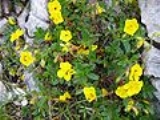
Helianthemum nummularium
Encyclopedia
Helianthemum nummularium (Common Rockrose) is a species of rockrose (Cistaceae
), native to most of Europe
.
Though the individual blooms are short-lived, the plant produces a mass of flowers through the summer. It needs a dry, sunny place, like a south-facing rockery or meadow. As the Latin name Helianthemum suggests, these are sun-flowers. This is a good nectar source for bees and there are several species of small beetle that feed on the foliage. Common rock-rose is also the food plant for the larvae of several species of moth and butterfly.
It flowers from May until July.
:
Cistaceae
The Cistaceae is a small family of plants known for its beautiful shrubs, which are profusely covered by flowers at the time of blossom...
), native to most of Europe
Europe
Europe is, by convention, one of the world's seven continents. Comprising the westernmost peninsula of Eurasia, Europe is generally 'divided' from Asia to its east by the watershed divides of the Ural and Caucasus Mountains, the Ural River, the Caspian and Black Seas, and the waterways connecting...
.
Description
It is an evergreen trailing plant with loose terminal clusters of bright yellow, saucer-shaped flowers. In the flower centre is a tight cluster of orange stamens, which are sensitive to the touch, and spread outwards to reveal the tall stigma in the middle. The plant is common on chalk downs, and occasional in other grasslands, always on dry, base-rich soil. Natural rockroses are yellow, but garden varieties range from white through yellow to deep red.Though the individual blooms are short-lived, the plant produces a mass of flowers through the summer. It needs a dry, sunny place, like a south-facing rockery or meadow. As the Latin name Helianthemum suggests, these are sun-flowers. This is a good nectar source for bees and there are several species of small beetle that feed on the foliage. Common rock-rose is also the food plant for the larvae of several species of moth and butterfly.
It flowers from May until July.
Subspecies
There are eight subspeciesSubspecies
Subspecies in biological classification, is either a taxonomic rank subordinate to species, ora taxonomic unit in that rank . A subspecies cannot be recognized in isolation: a species will either be recognized as having no subspecies at all or two or more, never just one...
:
- Helianthemum nummularium subsp. nummularium. Widespread.
- Helianthemum nummularium subsp. berterianum. Italy, southeast France.
- Helianthemum nummularium subsp. glabrum. Central and southern Europe.
- Helianthemum nummularium subsp. grandiflorum. Central and southern Europe.
- Helianthemum nummularium subsp. obscurum. Eastern Europe.
- Helianthemum nummularium subsp. pyrenaicum. Pyrenees.
- Helianthemum nummularium subsp. semiglabrum. Italy, southeast France.
- Helianthemum nummularium subsp. tomentosum. Southern Europe.

